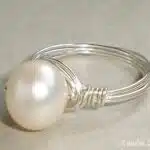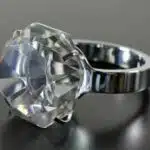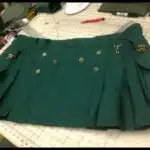Tarnished jewelry can be a real eyesore. It’s frustrating to open up your jewelry box and see that your favorite pieces are dull and discolored, especially if they hold sentimental value. Luckily, there are simple ways to clean tarnished jewelry and restore its shine.
As a jewelry cleaning expert, I’ve seen it all when it comes to tarnished pieces. Whether it’s silver, gold, or even costume jewelry, there are tried-and-true methods for cleaning each type of metal. In this article, I’ll share my top tips for safely and effectively cleaning tarnished jewelry so that you can enjoy your favorite pieces for years to come.
Identifying Tarnished Jewelry
Tarnished jewelry can be a frustrating sight for any jewelry lover. However, before you can clean your tarnished jewelry, it is important to identify whether the discoloration is actually tarnish or patina. Tarnish occurs when the metal in your jewelry reacts with substances in the air and on your skin, resulting in a dark or dull appearance. On the other hand, patina is a natural process that occurs when certain metals, such as copper and bronze, develop a thin layer of oxidation over time, giving them a unique and desirable look.
To differentiate between tarnish and patina, you need to examine the color and texture of your jewelry carefully. Tarnish usually appears as a dark or black coating on silver or gold-plated jewelry; it may also cause copper to turn green. In contrast, patina typically creates a green or blue-green stain on copper-based metals like brass or bronze. You may also notice that patinated metals have a rougher texture than tarnished metals.
As an expert in cleaning jewelry, it is vital to know how to identify different types of discoloration accurately. Failure to do so may result in irreparable damage to your favorite pieces of jewelry. By understanding the differences between tarnish and patina, you are one step closer to restoring your precious items’ original beauty. Next, we will discuss the causes of tarnishing so that you can take proactive steps in preventing them from happening again.
Understanding The Causes Of Tarnish
Tarnish is a common phenomenon in metals, including silver, gold, and copper. It refers to the discoloration or darkening of metal surfaces due to chemical reactions with environmental factors such as air, moisture, and other reactive substances. The Causes of Tarnish are varied; however, they can be categorized into three main groups: environmental factors, human factors, and inherent metal properties.
Environmental factors that cause tarnish include exposure to air and humidity. When exposed to air for a long time, metals react with oxygen which results in the formation of oxides on their surface causing discoloration. Humidity also contributes to tarnishing since moist air contains water vapor that reacts with metal surfaces causing corrosion.
Human factors such as handling jewelry with bare hands transfer oils from the skin onto metal surfaces. These oils contain chemicals that react with metals resulting in tarnish formation. Similarly, exposure to chemicals such as perfumes and lotions can also accelerate tarnishing.
Inherent metal properties also affect how quickly jewelry will tarnish. Some metals like sterling silver have a higher tendency to tarnish compared to others like platinum or titanium. Additionally, alloys made by mixing different types of metals may result in faster tarnishing times than pure metals. Understanding the Causes of Tarnish is crucial when seeking ways to prevent it from happening or restoring precious items that have been affected by it.
With an understanding of the Causes and Effects of Tarnish, it is now possible to assess the type of metal under consideration before deciding on how best to clean it up effectively.
Assessing The Type Of Metal
Identifying the type of metal used in jewelry is an important step when cleaning tarnished jewelry. Precious metals, such as gold, silver, and platinum, are distinguished from non-precious metals by their relative purity and durability. To identify the type of metal, a jeweler can use a variety of tools, including a jewelry loupe and a metal testing kit. Different precious metals have different cleaning techniques, so the type of metal must be accurately identified prior to cleaning.
Identifying Metal Types
As a jewelry cleaning expert, identifying metal types is crucial in assessing the type of metal and determining how to properly clean tarnished jewelry. Identifying metal allergies is also important to ensure the safety of the wearer. Common metals used in jewelry include gold, silver, platinum, and copper. However, some jewelry may be made from alloys or coated with other metals.
To identify the type of metal, testing metal purity is necessary. One way to test for gold and silver purity is through acid testing. This involves applying nitric acid to a small part of the jewelry and observing any changes in color or reaction. Another method is using a magnet to determine if the jewelry contains iron or steel.
It’s important to note that not all tarnished jewelry can be cleaned using the same method. Different metals require different cleaning techniques and solutions. Therefore, it’s essential to identify the type of metal before attempting any cleaning methods. By doing so, one can avoid damaging or ruining the piece of jewelry while effectively restoring its shine and luster.
Differentiating Precious Metals
As a jewelry cleaning expert, identifying the type of metal is one of the most critical steps in assessing and determining how to clean tarnished jewelry effectively. Precious metal identification is crucial since different metals require distinct cleaning techniques and solutions. Identifying precious metals such as gold, silver, and platinum requires expertise and knowledge.
Precious metal identification may involve using various methods such as visual inspection, magnet testing, acid testing, or electronic testing. For instance, checking the hallmark on a piece of jewelry can help identify the precious metal used in creating it. Additionally, observing the color and sheen of the jewelry can aid in identifying its metal type. Knowing how to differentiate precious metals plays a vital role in selecting appropriate tarnish removal techniques that will not cause any damage to the jewelry.
Differentiating precious metals is crucial for successful tarnish removal techniques. Using inappropriate cleaning methods for certain metals may lead to irreparable damage to your jewelry. Therefore, it’s essential to consult an expert when dealing with delicate or valuable pieces of jewelry that require special attention. By doing so, you’ll be able to maintain your precious collection’s shine and luster while ensuring that it remains safe from any potential harm caused by improper handling or care.
Preparing Your Workspace
Setting up your workspace is crucial when it comes to cleaning tarnished jewelry. Before you begin, imagine yourself as a jeweler who is about to craft a masterpiece. You want to prepare your space and organize all the necessary tools and materials to ensure that the job is done efficiently and effectively. This not only saves time but also guarantees a great outcome.
To start, choose a well-lit area in your home or workspace where you can comfortably sit down and work on your jewelry without any distractions. It could be a desk or table with ample space to spread out your tools. Once you have identified this location, take some time to declutter the area by removing any unnecessary items that may cause distractions or hazards while working.
Organizing your workspace is equally important as setting it up. Having everything within reach will make the cleaning process smooth and seamless. Consider creating a checklist of all the tools and materials needed for tarnished jewelry cleaning before starting. Arrange them in an orderly manner on your workspace so that you can access them easily during the cleaning process.
To recap, setting up and organizing your workspace are essential steps when it comes to cleaning tarnished jewelry. With these tips, you can establish a conducive environment that will help you achieve excellent results for every piece of jewelry that needs cleaning.
Transition: Now that we have our workspace ready, let’s move on to basic cleaning solutions perfect for removing tarnish from jewelry pieces.
Basic Cleaning Solutions
- Natural cleaning solutions are often preferred for cleaning tarnished jewelry, as they are gentle and can be found in most homes.
- Home remedies such as toothpaste, baking soda, and white vinegar are all commonly used to remove tarnish from jewelry.
- Commercial jewelry cleaning solutions are also available, and some of these are specifically formulated to remove tarnish from jewelry.
- Jewelry should always be soaked in a cleaning solution first, before brushing with a soft bristled brush to remove any dirt or grime.
- Jewelry should then be rinsed with warm water and then wiped with a soft cloth to dry.
- For more heavily tarnished jewelry, it may be beneficial to take it to a professional jeweler who will be able to properly clean and restore the piece.
Natural Cleaners
When it comes to cleaning tarnished jewelry, natural cleaners can be a great option. DIY recipes using household items such as baking soda and vinegar can effectively remove tarnish without harsh chemicals. These eco-friendly options are not only good for the environment but also gentle on your jewelry.
One popular natural cleaner is a mixture of baking soda and water. Simply make a paste with equal parts of baking soda and water, apply it to your tarnished jewelry, and let it sit for a few minutes before rinsing it off with warm water. Another option is white vinegar, which can be mixed with baking soda or used on its own by soaking your jewelry in the vinegar for several hours before gently scrubbing it clean.
While natural cleaners can be effective in removing tarnish from your jewelry, some metals may require different cleaning methods or professional care. It’s important to do your research before attempting any cleaning methods on your precious pieces. However, if done correctly, these eco-friendly options can not only restore the shine to your beloved jewelry but also give you peace of mind knowing that you have taken steps towards protecting the environment.
In conclusion, natural cleaners such as DIY recipes and eco-friendly options like baking soda and vinegar can provide an effective solution for cleaning tarnished jewelry without harsh chemicals. While these options may not work for every type of metal or piece of jewelry, they are worth considering as a first step in restoring the shine to your favorite accessories. Remember to always research proper cleaning methods before attempting any at-home solutions to ensure the longevity of your precious pieces.
Home Remedies
When it comes to cleaning jewelry, basic cleaning solutions can go a long way in restoring the shine and beauty of your pieces. However, not everyone has access to commercial cleaners or may prefer natural alternatives. In these cases, homemade solutions using common household items can be an effective option for removing dirt and grime from your jewelry.
Natural alternatives such as baking soda and white vinegar are popular options for at-home cleaning. Baking soda can be used to create a paste with water that is gentle enough for most metals and gemstones. Simply apply the paste to your jewelry and let it sit before rinsing it off with warm water. White vinegar can also be used on its own by soaking your jewelry in a mixture of one part vinegar to three parts water for several hours before gently scrubbing it clean.
While home remedies can be effective, it’s important to note that some metals and gemstones require specific care instructions. For example, pearls should never be soaked in water or exposed to harsh chemicals like vinegar or baking soda. It’s important to research proper cleaning methods before attempting any at-home solutions to avoid damaging your precious pieces. With careful research and attention, however, homemade solutions can provide an eco-friendly and cost-effective way of keeping your jewelry looking its best.
Commercial Solutions
Moving on from homemade solutions, commercial cleaners are another option for cleaning and restoring your jewelry’s shine. These solutions are specifically formulated to clean metals and gemstones without causing damage or discoloration. There are several pros and cons to using commercial solutions, so it’s important to consider these factors before making a purchase.
One advantage of commercial cleaners is their effectiveness in removing tough stains and grime. They often contain ingredients like ammonia or specialized enzymes that can dissolve dirt and restore the luster of your jewelry. Additionally, commercial cleaners typically come with instructions for use, which can help ensure that you’re using the product correctly and safely. However, one downside to commercial solutions is their cost. They may be more expensive than homemade alternatives, but for some individuals, the convenience and effectiveness may outweigh the added expense.
When comparing cost between homemade and commercial solutions, it’s important to consider the value of your time as well as the potential risks associated with using homemade remedies on certain metals or gemstones. While baking soda and vinegar are inexpensive options, they may not work for all types of jewelry or may require more time and effort on your part to achieve desired results. Commercial cleaners, on the other hand, offer a quick and easy solution that is specifically designed for use on jewelry. Ultimately, the decision between homemade or commercial cleaning solutions will depend on individual preferences and needs.
Using Baking Soda And Aluminum Foil
Baking soda and aluminum foil can be used to clean tarnished jewelry. This method is particularly useful for silver jewelry, but it can also work for other metals. Here is how to do it:
- Line a bowl with aluminum foil.
- Fill the bowl with hot water and add one tablespoon of baking soda per cup of water.
- Place your tarnished jewelry in the bowl, making sure that each piece is touching the aluminum foil.
- Let the jewelry soak for 10 minutes.
- Remove the jewelry from the bowl and rinse thoroughly with water.
Why does this method work? The baking soda reacts with the aluminum foil, which creates a chemical reaction that removes the tarnish from your jewelry. The process is safe and gentle on your precious pieces, so you don’t have to worry about damaging them.
But what if your jewelry is particularly stubborn or has intricate details? In that case, you might want to try using vinegar and salt or polishing with toothpaste instead. These methods can be just as effective, but they require a bit more elbow grease! Check out our table below for a quick comparison of all three methods:
| Method | Ease of Use | Effectiveness | Best for |
|---|---|---|---|
| Baking Soda and Aluminum Foil | Easy | Effective | Silver Jewelry |
| Vinegar and Salt | Moderate | Very Effective | Copper or Brass Jewelry |
| Polishing with Toothpaste | Difficult | Very Effective (for scratches) | Gold or Platinum Jewelry |
Next up: lemon juice and salt method! This technique involves using two common household ingredients to remove tarnish from your jewels. Stay tuned!
Lemon Juice And Salt Method
1.In order to use the Lemon Juice and Salt Method for cleaning tarnished jewelry, one must first gather the needed supplies, including fresh lemon juice, table salt, and a small bowl. 2.The lemon juice should then be poured into the bowl and the salt added, stirring until it forms a solution. 3.Before soaking the jewelry in the solution, it is important to check that the jewelry is solid enough to withstand the acidity of the lemon juice, as soft metals and stones can be damaged by the acidic solution. 4.After confirming the jewelry can withstand the solution, it should be soaked for a few minutes, depending on the severity of the tarnish. 5.Once the jewelry has finished soaking, it should be gently scrubbed with a soft toothbrush or cloth to remove any remaining tarnish. 6.Finally, the jewelry should be rinsed with clean water to remove any remaining lemon juice and salt residue.
Gather Supplies
To effectively clean tarnished jewelry using the Lemon Juice and Salt Method, it is essential to gather all necessary supplies. These supplies can be purchased from various stores or online retailers. One can purchase lemon juice from grocery stores or online marketplaces, while table salt is readily available in most homes. It is also important to have a soft-bristled toothbrush, polishing cloth, and a bowl for mixing the solution.
Creating a workspace is crucial when cleaning tarnished jewelry as it helps minimize mess and ensures that all essential tools are within reach. It is recommended to work on a flat surface such as a table or countertop where one has ample space to lay out all the supplies. A well-lit area is ideal for examining the jewelry and ensuring that no spots are missed during the cleaning process.
When purchasing essential supplies for cleaning tarnished jewelry, one should always opt for high-quality products that promise excellent results without damaging the jewelry. Additionally, having all the necessary supplies nearby saves time and ensures that one does not have to stop midway through the process to look for missing items. By gathering all these supplies before starting the cleaning process, one can ensure an efficient and effective outcome without any unnecessary interruptions.
Prepare Solution
Now that we have gathered all the necessary supplies and created a workspace, it is time to prepare the solution for cleaning tarnished jewelry using the Lemon Juice and Salt Method. To make the solution, mix one tablespoon of table salt with half a cup of lemon juice in a bowl. Stir the ingredients until they are well combined.
Once the solution is ready, apply it onto the tarnished areas of the jewelry using a soft-bristled toothbrush. Gently scrub the jewelry in circular motions, ensuring that every spot is covered. After scrubbing, let the jewelry sit for about five minutes to allow the solution to work its magic.
After waiting for five minutes, rinse off the jewelry with warm water and dry it with a soft cloth. The result should be clean and shiny jewelry that looks as good as new. By following these simple steps, you can effectively clean your tarnished jewelry using the Lemon Juice and Salt Method without causing any damage to your precious pieces.
Soak Jewelry
For jewelry cleaning enthusiasts, the Lemon Juice and Salt Method is a cost-effective and efficient way to restore the shine of tarnished jewelry. While scrubbing with a soft-bristled brush is effective in removing surface stains, soaking is another method that can help loosen dirt and grime that are deeply embedded.
Soaking jewelry in a solution can provide several benefits. It can effectively remove stubborn stains that cannot be removed by scrubbing alone. Additionally, it is an easy and hands-off approach to cleaning your jewelry, making it ideal for individuals who have busy schedules. However, not all solutions are created equal, and some may cause more harm than good.
To ensure that you get the best results when soaking your jewelry, it’s important to use the right solution. The Lemon Juice and Salt Method provides an excellent soaking solution for tarnished jewelry. After scrubbing with the lemon juice and salt mixture, soak your jewelry in warm water mixed with a few drops of dish soap for about 15 minutes. This will help break down any remaining dirt or grime on your pieces without causing any damage to them. Once you’re done soaking, rinse your jewelry with clean water and dry it with a soft cloth for amazing results.
Chemical Dip Solutions
Chemical dip solutions are an effective way to clean tarnished jewelry. These solutions are available in both liquid and gel form and contain chemicals that dissolve the tarnish on the surface of the metal. Dip solutions work well on silver, gold, and platinum jewelry.
Cleaning techniques for using chemical dip solutions vary depending on the type of solution being used. Some solutions require a quick dip followed by a rinse with water, while others require soaking for several minutes. Always follow the instructions provided by the manufacturer to ensure proper use and safety.
Safety precautions should always be taken when using chemical dip solutions. Wear gloves to protect your skin from exposure to harsh chemicals. Work in a well-ventilated area or wear a mask if needed. Keep these solutions out of reach of children and pets.
In the next section, we will discuss ultrasonic cleaners, another effective method for cleaning tarnished jewelry. Ultrasonic cleaners use high-frequency sound waves to remove dirt and grime from jewelry items. This method is particularly useful for cleaning intricate pieces with lots of crevices that are difficult to clean manually.
Ultrasonic Cleaners
Ultrasonic Cleaners are a safe and effective way of cleaning jewelry. Jewelry can be submerged in a cleaning solution, then agitated with sound waves to remove dirt, tarnish and oils. Benefits of using Ultrasonic Cleaners include the ability to clean hard to reach areas and reduce the amount of laborious scrubbing required for manual cleaning. Additionally, using Ultrasonic Cleaners can help restore jewelry to its original luster with minimal effort and time.
Using Ultrasonic Cleaners
Ultrasonic cleaners have become popular in the jewelry cleaning industry due to their efficiency and effectiveness in removing tarnish from jewelry. These machines use ultrasonic waves to create high-frequency vibrations that dislodge dirt and grime from the surface of the jewelry, leaving it clean and shiny. The advantages of using ultrasonic cleaners for cleaning tarnished jewelry include their ability to clean hard-to-reach areas, such as prongs and crevices, and their ability to clean multiple pieces of jewelry at once.
However, it is important to note that there are limitations to using ultrasonic cleaners for cleaning tarnished jewelry. For instance, not all types of jewelry can be cleaned with an ultrasonic cleaner. Delicate or fragile pieces, such as pearls or opals, can be damaged by the strong vibrations produced by the machine. Additionally, some types of gemstones may also be damaged if placed in an ultrasonic cleaner. It is best to consult a professional jeweler before attempting to clean any precious or delicate jewelry with an ultrasonic cleaner.
To ensure that your jewelry is cleaned properly without causing any damage, it is important to follow some best practices when using an ultrasonic cleaner. Firstly, always read the manufacturer’s instructions carefully before operating the machine. Secondly, use only water or a mild cleaning solution specifically formulated for use with an ultrasonic cleaner. Avoid using harsh chemicals or abrasive substances that can scratch or damage the surface of your jewelry. Lastly, always handle your jewelry carefully when removing it from the machine and gently dry it with a soft cloth before storing it away.
In conclusion, while there are advantages to using ultrasonic cleaners for cleaning tarnished jewelry, there are also limitations that must be considered. By following best practices and consulting a professional jeweler when necessary, you can safely and effectively use an ultrasonic cleaner on your precious pieces of jewelry.
Benefits Of Ultrasonic Cleaners
Ultrasonic cleaners have been gaining popularity in the jewelry cleaning industry due to their numerous benefits. One of the advantages of using an ultrasonic cleaner is its efficiency in removing tarnish and dirt from jewelry. The high-frequency vibrations produced by these machines dislodge grime from the surface of the jewelry, including hard-to-reach areas such as prongs and crevices. Compared to traditional cleaning methods, ultrasonic cleaners can clean multiple pieces of jewelry simultaneously.
Another benefit of using an ultrasonic cleaner is that it uses only water or mild cleaning solutions specifically formulated for use with these machines. This means that the risk of causing damage to your jewelry is significantly reduced since you are not using harsh chemicals or abrasive substances that may scratch or damage the surface of your precious pieces. Moreover, ultrasonic cleaners make it easy to keep your jewelry looking new without any additional labor-intensive scrubbing.
However, it is essential to note that there are limitations to using ultrasonic cleaners for cleaning tarnished jewelry. Delicate or fragile pieces like pearls and opals can be damaged by the strong vibrations produced by these machines. Additionally, some types of gemstones may also be damaged if placed in an ultrasonic cleaner. Therefore, it is recommended to consult a professional jeweler before attempting to clean any precious or delicate jewelry with an ultrasonic cleaner. By doing so, you can ensure that your jewelry will be cleaned effectively while minimizing the risk of damage caused by inappropriate use of an ultrasonic cleaner.
Polishing Cloth Techniques
After using an ultrasonic cleaner to remove dirt and grime from your jewelry, the next step is to polish it. Polishing cloth techniques are an effective way to clean tarnished jewelry and restore its shine. Choosing the right polishing cloth can make all the difference in achieving optimal results.
Here are some tips to keep in mind when selecting a polishing cloth:
- Look for a high-quality microfiber cloth that is specifically designed for polishing jewelry.
- Avoid using paper towels or other abrasive materials that can scratch the surface of your jewelry.
- Make sure the cloth is clean and free from any debris or particles before use.
- Use light pressure when polishing and avoid over-polishing, as this can damage the metal or gemstones.
While polishing at home can be a cost-effective option, there are also benefits to using a professional polishing service. A professional jeweler has access to specialized equipment and techniques that can achieve superior results.
In addition, professional services may offer additional benefits such as inspecting for damage or loose stones, repairing any issues found, and providing advice on how best to care for your jewelry moving forward. Consider seeking out a professional service if you have valuable or sentimental pieces that require extra care.
Next up, we will explore another method for cleaning jewelry: steam cleaning.
Steam Cleaning
Many people believe that steam cleaning is a harmful process for jewelry. However, this is not true. The truth is, steam cleaning is one of the safest and most effective ways to clean tarnished jewelry. It involves using high-temperature steam to remove dirt, grime, and tarnish from the surface of jewelry.
The benefits of steam cleaning include its ability to clean deeply embedded dirt and grime from tiny crevices in the jewelry without causing any damage. It also sanitizes the jewelry by killing bacteria that may have accumulated on it over time. Additionally, steam cleaning is an eco-friendly way of cleaning as it does not require the use of harsh chemicals that may harm the environment.
When choosing the best steam cleaning tools for your jewelry, look for those with adjustable temperature settings. This ensures that you can control the amount of heat used during the process and avoid causing damage to delicate stones or metals. Also, consider purchasing a small handheld steam cleaner as they are more convenient and easier to use than larger machines.
Now that you know about the benefits of steam cleaning and which tools to use, it’s important to note that professional cleaning services can provide an even deeper clean for your jewelry. These services have access to specialized equipment and expertise in handling different types of metals and stones. So if your jewelry requires extensive cleaning or restoration work, it’s worth considering taking them to a professional cleaner who can ensure their safety while restoring their shine.
Professional Cleaning Services
- Professional cleaning services may vary in cost, depending on the type of service being performed and the complexity of the work.
- Professional cleaning services may be available at local jewelry stores, as well as online providers.
- Types of professional cleaning services include hand polishing and steam cleaning, to name a few.
- Hand polishing can be used to restore minor tarnish to jewelry, while steam cleaning is more effective for more severe tarnish.
- Additionally, services such as ultrasonic cleaning and laser cleaning can be used to remove dirt and grime from jewelry.
- Professional cleaning is often the best way to restore jewelry to its original shine, and is recommended for items of special value.
Cost Of Professional Cleaning Services
As a jewelry cleaning expert, I have seen many people who are hesitant to clean their tarnished jewelry themselves. This is where professional cleaning services come in handy. However, the cost of these services can be quite high and may not be suitable for everyone’s budget.
One of the pros of using professional cleaning services is that they use specialized equipment and solutions that can effectively clean even the most stubborn tarnish from your jewelry. Additionally, professionals have years of experience in handling delicate pieces, which reduces the risk of damage to your jewelry. On the other hand, one of the cons is that it can be quite expensive and may not be feasible for those on a tight budget.
If you don’t want to spend a lot on professional cleaning services, there are several DIY alternatives available that can help you clean your tarnished jewelry at home. These include using baking soda and aluminum foil or vinegar and baking soda solutions. While these methods may require a bit more effort and patience, they can provide good results without breaking the bank.
Overall, while professional cleaning services may be convenient, they can also be expensive. It’s important to weigh the pros and cons and consider DIY alternatives before deciding whether to go down this route or not. With some research and experimentation, you may find that you’re able to restore your tarnished jewelry to its former glory at home!
Availability Of Professional Cleaning Services
When it comes to cleaning tarnished jewelry, there are different options available for people to choose from. One of these options is professional cleaning services. These services vary in availability and can be found in jewelry stores, specialized shops or even online. However, the cost comparison between DIY methods and professional cleaning services is a factor that people must consider.
One of the pros of professional cleaning services is that they have trained personnel who have years of experience handling delicate jewelry pieces. This reduces the risk of damage to the jewelry while effectively removing any tarnish present. Additionally, many professional cleaners use specialized equipment and solutions that provide better results than DIY methods. On the other hand, one of the cons is that they can be quite expensive compared to doing it yourself.
The availability of professional cleaning services also varies depending on where you live. In some areas, there may be several options available while in others there may only be a few or none at all. Moreover, people must take into account the transportation costs if they need to travel far for these services. Thus, weighing the pros and cons of professional cleaning services is crucial before deciding whether it’s worth investing in them or not.
Types Of Professional Cleaning Services
When it comes to cleaning tarnished jewelry, some people prefer to have their pieces professionally cleaned. Professional cleaning services vary in availability and cost, but they offer a number of benefits over DIY cleaning methods. One important consideration when choosing professional cleaning services is the type of service that will best meet your needs.
There are different types of professional jewelry cleaning services available, depending on the type of jewelry you have and the level of cleaning required. Some jewelers offer basic cleaning services that involve soaking your jewelry in a special solution to remove dirt and grime. Others offer more specialized services, such as ultrasonic cleaning or steam cleaning, which use high-frequency sound waves or steam to clean deeper into the crevices of your jewelry.
The cost of professional cleaning services can be a factor for many people. Basic cleaning services are generally less expensive than more specialized options, but they may not be effective for heavily tarnished or dirty jewelry. It’s important to weigh the costs against the benefits of each type of service before deciding which one is right for you. Additionally, many jewelers offer discounts or package deals for multiple pieces or regular cleanings, so it’s worth asking about these options to help offset the cost.
Storing Your Jewelry To Prevent Tarnish
Professional cleaning services are a great way to restore the shine and luster of your tarnished jewelry. However, it is also important to take preventive measures to reduce the likelihood of tarnish reoccurring. Proper jewelry storage can go a long way in preventing tarnish from forming.
Firstly, it is important to store your jewelry in a dry and cool place. Humidity can cause jewelry to tarnish quickly, so avoid storing them in areas with high humidity levels such as the bathroom. Instead, consider investing in a dry box or silica gel packets to absorb any excess moisture.
Secondly, keep your jewelry away from direct sunlight and heat sources such as radiators or fireplaces. Exposure to heat can cause metals to expand and contract, leading to small cracks that can trap dirt and accelerate tarnishing.
Lastly, consider using anti-tarnish strips or pouches when storing your jewelry. These specially designed strips contain chemicals that neutralize airborne sulfur which causes tarnishing. Anti-tarnish pouches are made of materials that prevent air and moisture from coming into contact with the jewelry.
By taking these simple steps to properly store your jewelry, you can significantly reduce the likelihood of tarnish developing over time. In the next section, we will discuss some additional tips for preventing tarnish on specific types of jewelry pieces.
Tips For Preventing Tarnish
Imagine receiving a beautiful piece of jewelry from your loved one, only to find it tarnished within a few weeks. Tarnishing is a common problem that most people face with their jewelry. However, this can be prevented by following simple maintenance and storage practices.
Maintenance is key to preventing the tarnishing of jewelry. One way to maintain your jewelry is to clean it regularly using mild soap and water. Avoid using harsh chemicals or abrasive cleaners as they can damage the surface of the jewelry. Additionally, remove your jewelry before engaging in activities such as swimming or exercising as sweat and chlorine can cause tarnishing.
Storage is another important factor when it comes to preventing tarnish on your jewelry. Always store your jewelry in a dry place away from moisture, which can accelerate the tarnishing process. Consider investing in anti-tarnish strips or bags that absorb moisture and prevent oxidation. Furthermore, avoid storing different types of metals together as they may react with each other and cause tarnish.
In summary, maintaining and storing your jewelry properly are crucial in preventing tarnishing. By following these simple tips, you can enjoy wearing your favorite pieces for years without worrying about discoloration or loss of shine. In the next section, we will address some frequently asked questions about cleaning and caring for your jewelry.
Frequently Asked Questions About Jewelry Cleaning
Cleaning techniques are essential for keeping your jewelry looking its best. However, there are some frequently asked questions about jewelry cleaning that can be confusing for people who are new to the process. One of the most common questions is how often you should clean your jewelry. The answer depends on how often you wear your jewelry and what type of metal it is made from.
For gold or silver jewelry, regular maintenance tips include using a soft-bristled brush and mild soap to gently scrub away dirt and oil buildup. For more delicate pieces, such as pearls or opals, it’s best to avoid harsh chemicals and instead use a polishing cloth or simple soap and water. Additionally, storing your jewelry in a dry, cool place can prevent tarnishing and discoloration over time.
Another common question is whether or not you can clean tarnished jewelry at home. The answer is yes, but it’s important to use caution when doing so. There are many DIY cleaning methods available online, but not all of them are safe for all types of jewelry. It’s always best to consult with a professional jeweler before attempting any cleaning techniques yourself.
In conclusion, proper cleaning techniques and maintenance tips are essential for keeping your jewelry looking shiny and new. If you have any questions or concerns about cleaning your jewelry at home, don’t hesitate to reach out to a professional for guidance. With the right care, your favorite pieces can last a lifetime!
Conclusion
In conclusion, cleaning tarnished jewelry can be a daunting task, but with the right tools and knowledge, it can be done effectively. Identifying the tarnish and understanding its cause is crucial in determining the proper cleaning method. Assessing the type of metal ensures that you use the appropriate cleaning solution to avoid further damage.
Preparation is key when cleaning your jewelry, so it’s essential to ensure that you have everything you need before starting. Basic cleaning solutions are often effective in removing tarnish; however, for more delicate pieces or valuable items, professional cleaning services may be necessary.
Storing your jewelry correctly after cleaning is also vital in preventing future tarnish. Follow our tips on preventing tarnish to maintain your jewelry’s shine for years to come. As a jewelry cleaning expert, I recommend taking care of your jewelry regularly to avoid significant build-up and damage over time. Remember to handle your pieces with care and seek professional assistance if needed. Happy cleaning!
Image Credits
- “Chalcopyrite with artificial tarnish 1” by James St. John (featured)





























